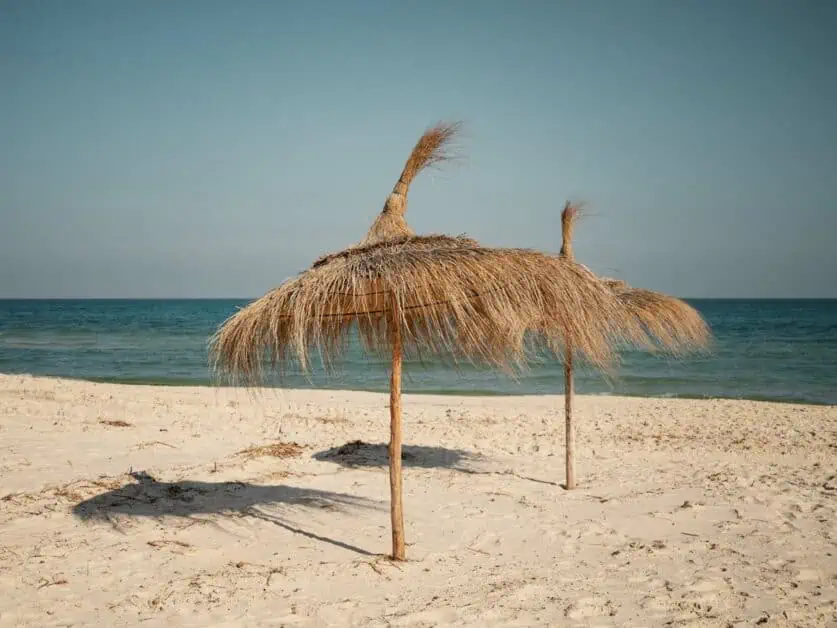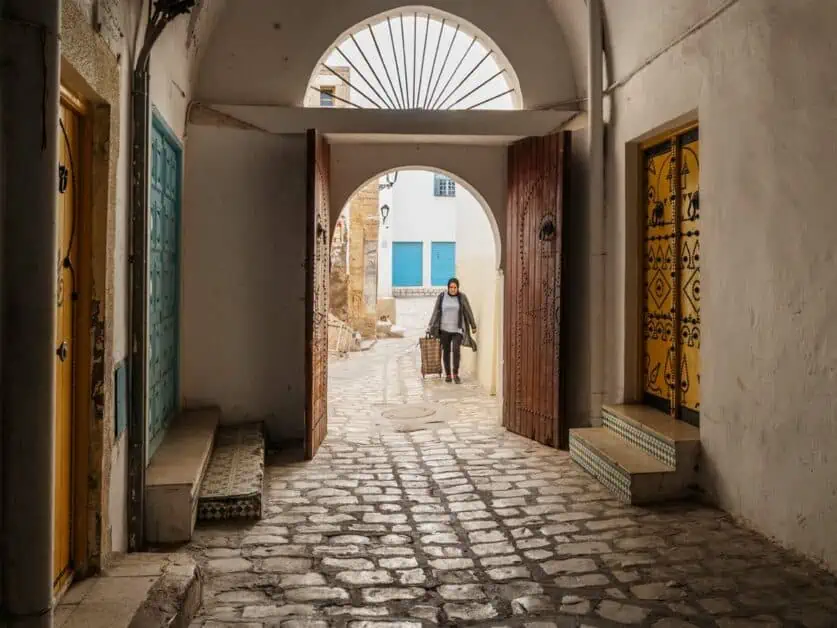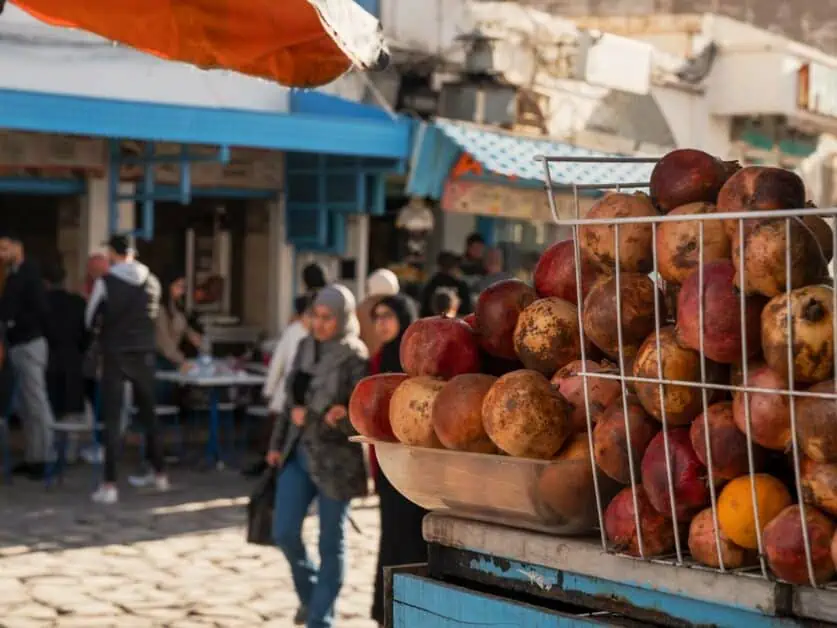Tunisia is without a doubt a very popular holiday destination – it is well known for its relatively short flight time from most of Europe, year-round warm temperatures, sunshine, culture, history, and value for money. The surrounding Mediterranean Sea offers something spectacular for those who are in search of beautiful beaches soaked with warm sunlight all year as well as boasting ancient Roman Ruins, Sahara Desert adventures and a rich culture of vibrant food and drink traditions. Whilst its popularity for package holidays is second to none, there are many areas of Tunisia, and experiences on offer in this fantastic part of North Africa, that are often overlooked. Whether you’re interested in cities, exploring ancient ruins, 4×4’ing in the desert or learning to make harissa from scratch, this guide outlines some of the best things to do in Tunisia for all tastes, interests, and budgets.

Best Things to do in Tunisia
There is so much to explore in Tunisia, and some of the most popular resorts offer a great springboard to see what the country has to offer. Even if you just pick one of two of the suggestions below, you’re sure to get an introduction and immersion to Tunisia, from culture and history to food and drink and so much more. Here are some of the highlights to consider when visiting Tunisia.
Escape to the Coast of Tunisia
Well known for its coastline, visiting beautiful beaches is one of the best things to do in Tunisia. Depending on where you fly into Tunisia and where you decide to stay, you can find incredible coastline dotted along most of the Eastern side of the country. Just one hour South of Tunis, the capital city, you’ll find Hammamet, the original beach resort of Tunisia. White sands stretch for miles with turquoise waters which are perfect for snorkelling. Hammamet itself is surrounded by 13th century walls with a Mediterranean feel that is incredibly picturesque.
Sousse, a little further down the coast (roughly an hour from Hammamet and just under two from Tunis) is a very popular resort area which boasts a UNESCO listed medina in its midst, a ribat and wonderful harbour amongst other attractions. This is a real working city, but its beaches are fantastic for a break that’ll have you drifting off to pure relaxation. What’s also great about Sousse is that it is easily served by Enfidha-Hammamet International Airport with daily international flights to and from Europe a short 30-minute drive away.
Monastir, a further 30 minute drive down the coast from Sousse is well known for its slightly quieter feel with extremely clear waters and it’s impeccable golden sands. You won’t go without your historical sites here either – much like Sousse, it has it’s own ribat, as well as the Great Mosque, which is well worth visiting when you can find the will power to prize yourself from the beach. Monastir itself has a nearby airport (Monastir Habib Bourguiba International) which makes this a great base for a relaxed holiday, with regular flights to most of Europe.

Visit Tunisia’s Historical Monuments and Roman Ruins
Tunisia has a lot to offer in terms of historical monuments, ruins and other areas rich in history. In fact, various areas of Tunisia are UNESCO recognised, such as the ribat of Sousse. So, you’re never far away from exploring more about this incredibly interesting country, wherever you’re staying. In history, Tunisia was significant to Roman and Phoenician civilisations, with an important area being Carthage; a large archaeological site set in the Gulf of Tunis. Aside from this, there are plenty of areas to explore if you want to learn more about the imprint of history Tunisia has to offer – and exploring the historical remnants is a great activity.
If visiting Sousse for example, you can visit the ribat, located in the central medina which offers an insight in the form of a Roman fortress. There are extensive information signs all around to learn as you visit. You can climb up the steps to see the views out (which are also fantastic) and get a real sense of time gone by. Afterwards, a short walk away is the Sousse Archaeological Museum, which is well worth visiting too.
Another popular place to visit is the Amphitheatre of El Gem which is staggering to see. It’s very possible to take tours from Tunis, Sousse and Monastir and you can also take a private taxi inexpensively. Walking around this amphitheatre, built around 238 AD, presents one of the most well preserved Roman stone ruins in the world. It’s also extremely unique in Africa. You may also recognise it from such films as Monty Python’s Life of Brian and its also featured in countless commercials by brands like Nike and various TV shows. There are of course a whole host of other historical monuments to explore – and this gives you some indication of the vast and rich history that Tunisia has to offer.

Head to the Capital, Tunis
The bustling capital city of Tunis is one of the best places to visit in Tunisia. If you want to see history still visible today, then head to the medina. From here, you can take a walk around the narrow streets which are lined with sellers, or souks, some of which date back to the 13th century, offering everything from clothes and leather goods, rugs, food and fresh herbs, spices, and traditional Tunisian fair. Souks of note are Ech-Chaouachine, El Attarine and El Berka.
What’s also great about Tunis is it offers the best of both worlds – with the historical medina meeting newer shopping, city streets and other attractions. There is a rich array of restaurants, café culture and a host of shopping to be had in the newer city streets. A couple of days will allow you to explore what Tunis has to offer before moving on, but if you are shorter on time, even just a day visit will give you a great taster. If you’re staying in somewhere like Sousse, or Hammamet, for example, you can easily take a relatively inexpensive taxi that’ll take just under 2 hours from Sousse, and 1 hour from Hammamet.

See the Sahara Desert
To the South of Tunisia, reaching for 370 miles into Algeria with dunes that dominate up to 300 metres high in places, the Sahara Desert is one of the best things to do in Tunisia and offers a less visited, more unique experience than some other areas of the Sahara.
There are so many tours of the Sahara on offer, and spend any time looking at the marketing emails for your airline or in your hotel, you are sure to be offered a tour that takes this area in. Depending on where you’re staying, experiences of the Sahara Desert are usually offered as between 2-4 days. You can also book experiences directly with the likes of Get Your Guide, Trip Advisor and many airlines will offer these directly too. Overnight tours will take you far into the dunes for a true wilderness experience and you can also explore Jebil National Park from here too. This provides a gateway to the Ksar Ghilane Oasis where you can experience traditional Berber tents and hospitality. In fact, visiting the Sahara is one of the best ways to experience Berber culture and way of life.
Alternatively, if you need to organise your own transport to the Sahara, most tours will start from the town of Douz, which is just under 6 hours/539km by car from Tunis.

Explore Tunisia’s Traditional Markets and Souks
The Souks in Tunisia are one of the best ways to get immersed in the culture of the country. Visit any city or large enough town and you’ll find a vast network of maze-like streets, usually with high walls of the surrounding buildings where you can dive into all that is on offer. You’ll find spices, fresh foods, lotions, teas, perfume, leather goods, textiles, clothing and so much more. They’re completely unique, and each city or town has a different feel. In Sousse, for example, the souks located in the medina are very different to the souks in Tunis. Tunis, understandably has more that stretch greater distances through the medina and old quarter, with notable ones being Ech-Chaouachine, El Attarine and El Berka.
Be prepared to haggle, as this is part of the culture and remember that you are likely to get bustled into shops before you know it – the sellers are very persistent! The souks are also a great place for street photography, and you’ll find some wonderful scenes and vignettes all around you. If you want an experience where you can just get lost in the sights, sounds and smells of the city, visiting the souks is one of the best things you can do in Tunisia.

Take in the Interesting Mix of North African and Mediterranean Buildings
Spend any time in Tunisia and you’ll see there is a unique mix of buildings, some of which take nods from the dominant cultures in the area. One such interesting mix is the marriage of North African and Mediterranean style buildings. Think of the kind of buildings you may more expect to see in somewhere like Santorini, and you won’t be far off the mark. This is largely down to the strong influence of immigration of Berber, Turkish and Arabic people as well as Spanish and French people. The French occupation of 1881 caused great unrest and Tunisia has only technically been independent since 1956. So, when taking in the influence you’ll see on the buildings, particularly in coastal resorts, it gives an opportunity to reflect on this.

Try Traditional Tunisian Food
Food is a big part of life in Tunisia, and you’ll be amazed very quickly at the complexity of flavours you can expect to experience in Tunisian food. Tunisian food is bold and hearty, and you will certainly not go hungry! Whilst there is a big emphasis on meat and fish, it is entirely possible to eat naturally vegetarian and vegan in Tunisia too. Some of the most popular dishes in Tunisia are Couscous, usually cooked in a big tagine topped with vegetables, and/or meat and fish but is also offered as entirely vegetarian. Pasta, which is usually nouacers (squares), noodles or m’hasmsa is quite differently to the sort of dishes you’ll find in Italy, for example, and is served with soups, chickpeas, meats and spices that add an individual flavour.
Of course, there is a lot more to explore in Tunisian cooking, and we’d recommend indulging in a cookery course (there are various offered in some of the biggest cities, and you can find these kinds of experiences on sites like Get Your Guide and Trip Advisor). Food is generally a family thing, and these courses will usually collect you, take you shopping and then cook as a family.
Harissa originates from Tunisia, coming from the region of Cape Bon and learning to make this unique, spicy, fragrant paste that is used as the basis for many dishes in a whole range of Arabic countries is one of the best things to do in Tunisia. As with other dishes, there are many courses on offer that allow you to learn how to make this paste that you’ll want to take back with you and never get store bought again!

Explore Sidi Bou Said
20 minutes away from Tunis is Sidi Bou Said, a beautiful coastal town well worth visiting. It’s great for a day trip from the capital, or a lovely place to visit as you are heading South down the country. Here you’ll find some of the most obvious Mediterranean style buildings which are whitewashed with dome like structures – you’d be forgiven for thinking you’ve transported to a Greek Island like Santorini.
Sidi Bou Said is popular for its beaches and clear waters, and from the hills you’ll get to see the Gulf of Tunis, making it one of the best things to do in Tunisia. Sidi Bou Said has a lot to offer in terms of culture too, there are some great cafes and restaurants here, as well as art galleries, museums and much more.

Best Travel Tips for Tunisia
Tunisia is a warm and friendly country, with a lot to offer. Regardless of what interests you, you’ll likely find it here, from adventure to history. Here are some of our top tips to consider when visiting Tunisia to have the best experience possible.
How to Get to Tunisia
Tunisia has quite a few airports, but the three that are most useful to enjoy the best things to do in Tunisia are Tunis-Carthage International Airport close to Tunis, Enfidha-Hammamet International Airport, close to Sousse and Hammamet and Monastir Habib Bourguiba International Airport for Monastir and the South.
You can fly to and from a good variety of European and UK airports daily, or mostly daily, pretty much all year round from these with many airlines offering reasonably priced flights and packages.
Best Time to Visit Tunisia
Tunisia is best to visit outside of the main summer months as it can become extremely hot. July and August can become unbearable, especially if you’re looking to explore more (though it’s still very popular for beach holidays). Therefore, the best time to visit Tunisia is between April and June and September to November. That said, December and January present cooler temperatures (between 15-20 degrees Celsius) which is great for exploring and still with plenty of sunshine.
How to Travel Around Tunisia
It’s usually pretty easy to get around Tunisian cities and resorts by taxi. You will usually find these along the streets – but be sure to agree a price (and make sure it’s for your whole group) before getting in. The traffic can also be chaotic, so make sure to wear your seatbelt. You can generally catch buses too, but these can be hard to navigate, so taxis are usually your best mode of transport, and they are not expensive. In terms of tours, be sure to book with a reputable company who have good reviews. These will generally pick you up from your hotel or at a pre agreed location.

Be Street Smart
Like with any destination, you need to have your wits about you. However, Tunisia does have quite a high amount of petty crime and theft, so we’d recommend having a padlock on a backpack, or keeping your bag small and on your front so you can see it with you. There are also a few old tourist tricks that some local sellers may try to lure you into a shop and tell you that they’re from your hotel. Just ignore them and walk past. You will get accosted, and people will try to sell you things, but just be firm and say no, unless of course you want to buy. In souks and smaller areas, be sure to keep your wallet and phone as close as possible. Preferably in a zipped up pocket you can see at all times.
How Long Do You Need for a Trip to Tunisia?
You could spend a long time travelling around Tunisia as there is quite a lot to see and do, but the optimal time would be 10-14 days to allow you to fully explore and make the most of travelling a little bit slower. This would also give you time to visit the Sahara as well as some of the older cities and monuments as well as relaxing on the beach. However, it is possible to explore Tunisia within a week too.
What to Pack for a Trip to Tunisia
Layers: What you pack will be dependent on when you visit Tunisia, what you plan on doing and where you go. It’s generally warm, so bring cool layers for the daytime. In the evening, especially in the desert, it can become cold, and especially in winter so bring warmer layers. Whilst Tunisia is pretty progressive, and doesn’t require modest dress as such from travellers, if you’re going to be visiting traditional buildings, be as respectful as possible and cover shoulders etc and avoid scant clothing.
Sunscreen: The sun pretty much always shines in Tunisia, so a good quality sunscreen will make all the difference. Be sure to bring a hat too.
Money: You will generally want to have some cash – the local currency is Tunisian Dinar, and it is best to get this when you arrive. Many places will not accept anything other than cash. Be sure to spend it before you leave though as you most likely won’t be able to spend cash at the airport.
Insurance: Like with any destination, you’ll want to make sure you have adequate travel insurance, and if you already have a policy in place, such as a yearlong polity, make sure it covers Tunisia.
Enjoy Tunisia
As you can see, Tunisia presents a great opportunity to get the best of both worlds – it has so much to offer in terms of adventure, in places like the Sahara Desert through to ancient Roman ruins in cities like Sousse. When you add in the pretty much year round good weather alongside the rich culture of food, bursting with flavour, you have a pretty much perfect destination. This list just scratches the surface of what Tunisia has to offer, and it’s a country that invites you to explore. We hope our guide to some of the best things to do in Tunisia gives you some inspiration and gets you planning a trip you won’t forget in a hurry.
